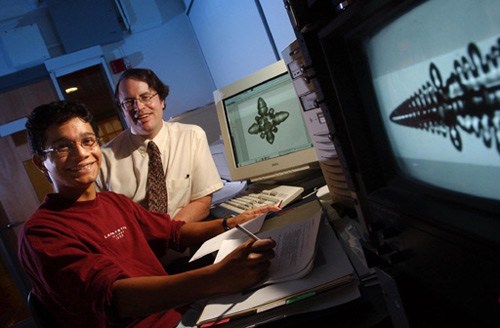Mayank Lahiri ’05 (Bombay, India) is working this summer as an EXCEL Scholar with Andrew Dougherty, associate professor of physics, on “The Emergence of Dendritic Crystal Growth,” a project that involves his majors in physics and computer science.
“Crystals are very common structures in nature, and can be incredibly complex geometrically,” explains Lahiri. “While the most common example of crystal formation is the snowflake, almost all metals form crystals as they solidify. We are studying the very early stages of crystal growth in an effort to understand the origins of these complex growth patterns. This has applications in various disciplines, including metallurgy.”
Dougherty says they are studying the emergence of complex dendrites from initial simple and well-controlled conditions.
“We expect to compare our observations with theoretical predictions and computer simulations,” he explains. “Long term, it is hoped that a better understanding of the ways dendrites form can lead to an increased understanding of the macroscopic properties of alloys.”
Lahiri says the EXCEL project is providing “incredible exposure” to research and to the way in which the scientific community functions through the exchange of knowledge. He has learned how to read and understand scientific papers, and since the project involves much data analysis, how to apply his computer science skills to complete a task.
“In that sense, this project has also been a great interdisciplinary exercise, the likes of which I hope to model my senior honors thesis on someday,” says Lahiri. “There’s been a dramatic improvement in my organizational skills, which has been an absolute necessity given the sheer volumes of data we have to crunch through. I’ve also become proficient in using the industry-standard math processing packages, and am seeing how some of the mathematical techniques we learn in class are applied in the real world.”
Dougherty says that Lahiri’s organizational skills have been particularly noteworthy. An example is his analysis of more than over a gigabyte of data using multiple models, each with differing assumptions. In doing this, he managed to keep all the results straight and present them in an organized way so they could decide what to try next. Previously, Dougherty did some exploratory work with Andrew Wright ’00 and James Reeder ’03, who redesigned the temperature control system to the precision and stability needed for this project as well as acquiring some early data.
“Mayank’s joint interest in physics and computer science has worked very well for me,” says Dougherty. “At the beginning of the summer, I had a lot of raw data, but had yet to analyze it to compare with theory. Analyzing it has involved using a wide array of tools, from complex Excel worksheets to Mathematica notebooks to C-language programs Mayank has written himself. Mayank has moved smoothly among all these different environments, under both Windows and Unix, and has easily learned what he needed as he went along. He has also been learning how to look critically at the computed results and ensure they make physical sense before proceeding.”
Unlike textbook problems, Dougherty says that research projects expose students to problems where the answer is not known ahead of time, and where there may not even be a simple answer. For example, one of Lahiri’s tasks has been to carefully determine the shape of the growing dendrites.
“This has proven far more complicated than I originally imagined,” says Dougherty. “There are several competing theories for the crystal shape, but none accurately fit our data. Further, there have been unexpected complications in applying each of the theoretical models.”
Lahiri says this first experience with Dougherty has been “terrific.” He appreciates the fact that Dougherty takes the time to explain every aspect of their work together. He is impressed that this research experience is available at the undergraduate level and since research is the career path he is considering, this project provides the perfect summer opportunity, notes Lahiri.
“To be working on a research project at the end of my freshman year is truly amazing, and Lafayette’s small size makes it much less intimidating than it might have been at a larger university,” he says. “At Lafayette, it’s a more symbiotic relationship; you get the professor’s work done, and you learn an incredible amount at the same timeFor the undergraduate level, this is the ideal environment.”
What really gets him excited, says Lahiri, is that he is conducting useful research, not a controlled lab demonstration.
“Our work is actually going to contribute in some way to the wealth of human knowledge,” says Lahiri. “No amount of lab sessions or classroom demonstrations can ever live up to that.”
Lahiri is a resident adviser, a Writing Associate, a DJ for the campus radio station, and a climbing wall monitor at Kirby Sports Center. He also serves on the executive committee of International Students Association and participates in intramural soccer, basketball, and volleyball.

Mayank Lahiri ’05 studied the early stages of crystal growth to better understand their complex growth patterns in an EXCEL Scholars project with Andrew Dougherty, associate professor of physics.
